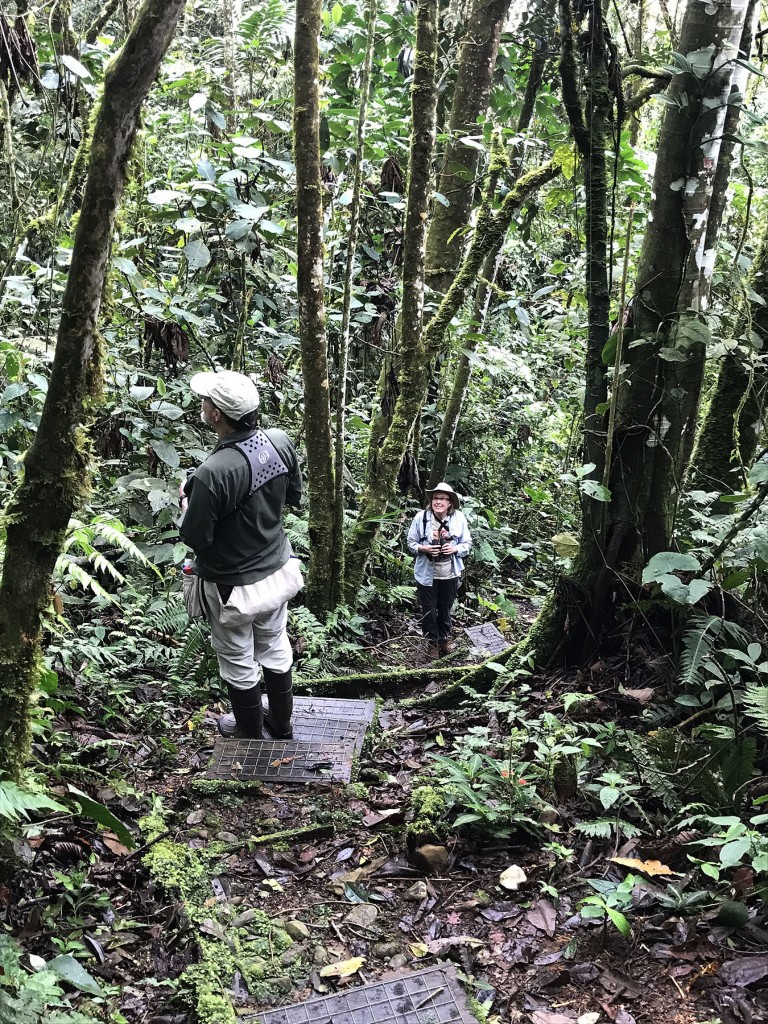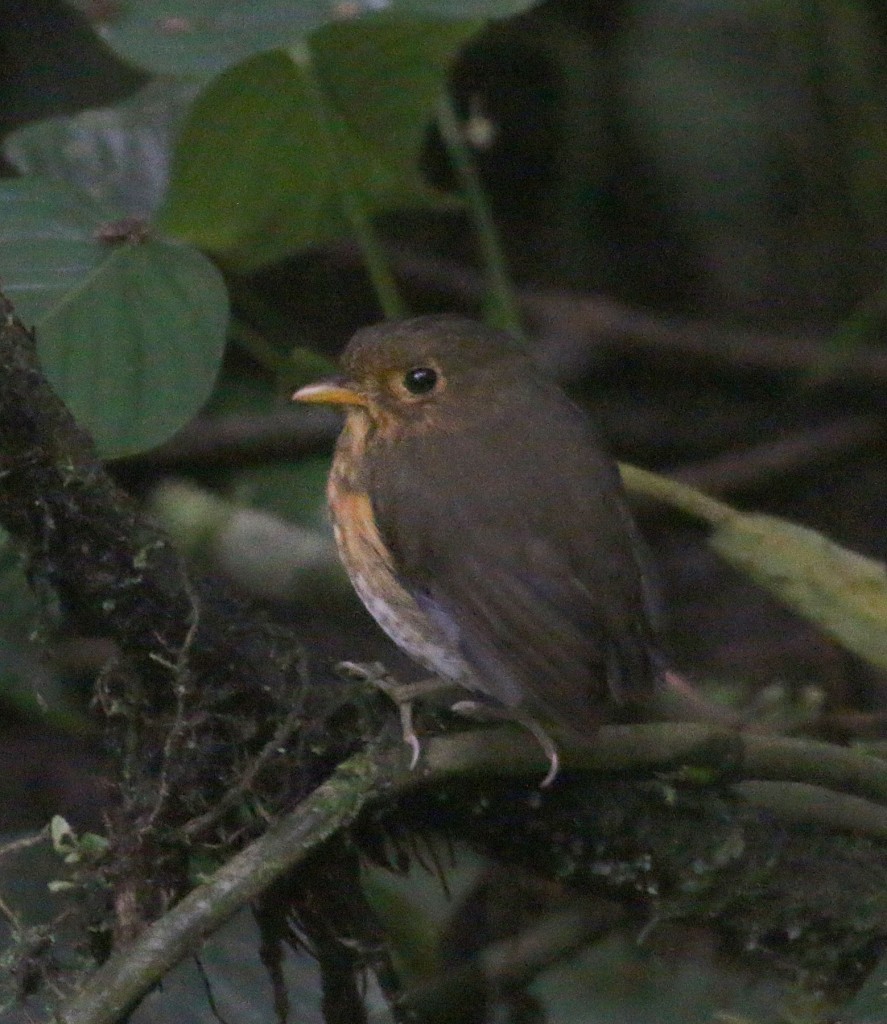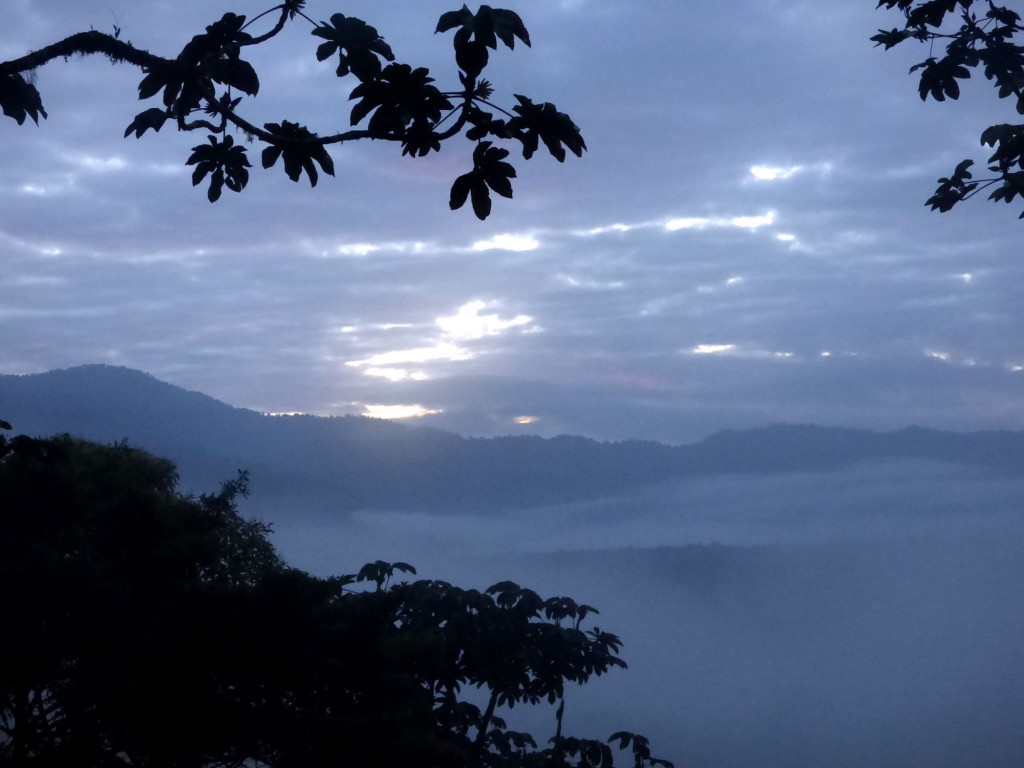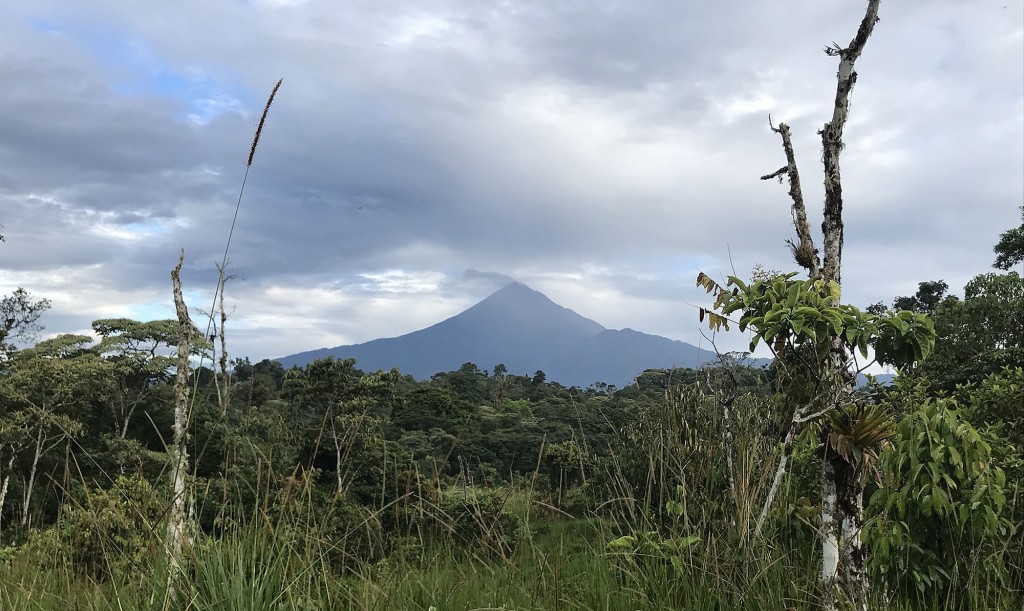The next four days of our trip were spent in the area surrounding Wildsumaco Lodge. Although Wildsumaco is further along the Loreto road from Narupa Reserve, it is actually at a slightly higher elevation (3,590 ft at Narupa, 4,900 ft at Wildsumaco). There is considerable overlap therefore in the species seen at the two locations. Wildsumaco has a stronger reputation than Narupa, due to the advantages of having a comfortable lodge with enough rooms to handle group tours and an extensive well-maintained trail system that provides access to excellent forest, whereas there is only sparse lodging (besides the two-room Cabañas Cascada Rio Hollin) to stay overnight near Narupa Reserve.
Birding began soon after we exited the Loreto Road at the village of Wawasumaco, driving on the ~6 km unpaved (and at times rough for our non-4WD vehicle) access road to the lodge. For approximately half of that distance the road passes through disturbed habitat that allowed us to stop occasionally and search for birds in the open areas. Several Swallow-tailed Kites flew overhead, we found our first Masked Tityra, and Blue-rumped Manakin and Buff-throated Saltator made brief appearances. Upon arrival at the lodge we settled into our new surroundings and immediately were provided with a late lunch. Lodging at Wildsumaco includes three meals per day (complete with soup and dessert), so we ate far more here than we typically do at home.

Dining at Wildsumaco Lodge. The fireplace with its nearby sofas at the far end of the lodge was a great place to re-live the day’s sightings.
Over the next few days we explored the Wildsumco trails and walked the road ~1 mile beyond the lodge toward the village of Pactosumaco. Mornings were typically spent near the lodge, starting in the parking area where birds were drawn in to feed upon insects that accumulated near the lights. Here we found our first Collared Trogon up close and personal, and Cerulean Warblers were feeding low, but we couldn’t find the nearby and very vocal Barred Forest Falcon. After breakfast we then explored the trails or walked the road. Our best forest birds included Fulvous Shrike-Tanager, Montane Foliage-gleaner by the Research Station, and we worked hard to identify a Golden-winged Manakin. On one rainy walk on the F.A.C.E. trail one of the employees interrupted his trail maintenance duties to show us a well-hidden Band-bellied Owl. It can be difficult to spot birds in the dense forest, so we enjoyed the change of pace when birding the open areas near Pacto, where we found both Chestnut-bellied and Black-and-white Seedeaters, Scaled Pigeon, and Bronze-green Euphonia.
On two days we took the ~15 minute walk down the Coopman’s Trail to the antipitta feeding station. Most lodges only attempt feedings in the morning, but at Wildsumaco they provide worms both in the morning and at 3PM. At both feedings Plain-backed and Ochre-breasted Antipittas made multiple appearances, and they were joined both days by a White-crowned Tapaculo. It was quite amazing to view such difficult species in close quarters. These ‘high-quality’ birds were joined by Gray-cheeked Thrush, a species that we see back home in New Jersey. It struck me how similar the antpittas were to the thrush in appearance and feeding style, looking like longer-legged thrushes without a tail. On our return back from the feeding area we spotted a Yellow-throated Toucan calling from a distant treetop (toucans always seem like a treat), and both Red-headed and Gilded Barbets were nice to see.
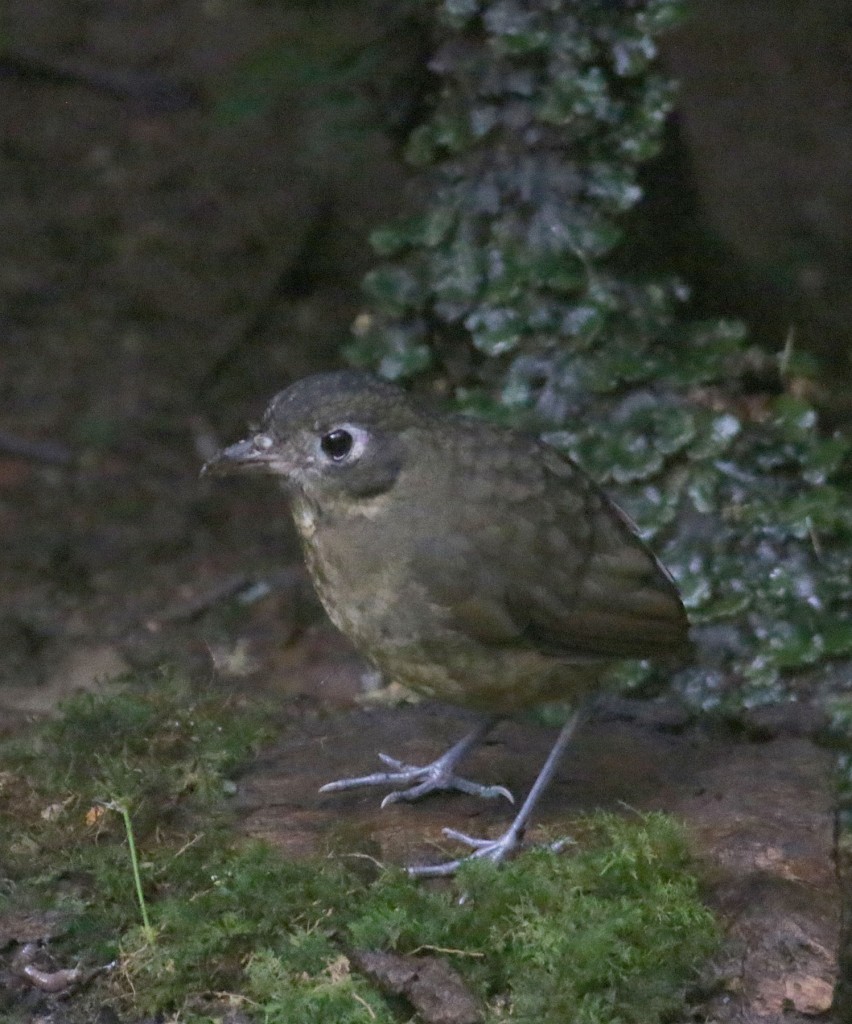
The appropriately-named Plain-backed Antpitta is nearly twice the size of its Ochre-breasted relative.
Birding was good and with a relaxing change of pace at the Wildsumaco veranda, where we could sit and watch Golden-collared Honeycreepers feed consistently in the cecropia trees, joined by occasional surprises. One afternoon Jeanine spotted a Golden-collared Toucanet skulking in a tree just a few feet behind the hummingbird feeders and the following morning she spotted a Sickle-winged Guan walking along the sturdier branches. A band of Napo Tamarin monkeys had daily excursions to feed on bananas hung in a tree near the veranda. Of course, the hummingbird feeders were delightful and constantly busy, although with much overlap with the species that we saw at Narupa Reserve the previous two days.
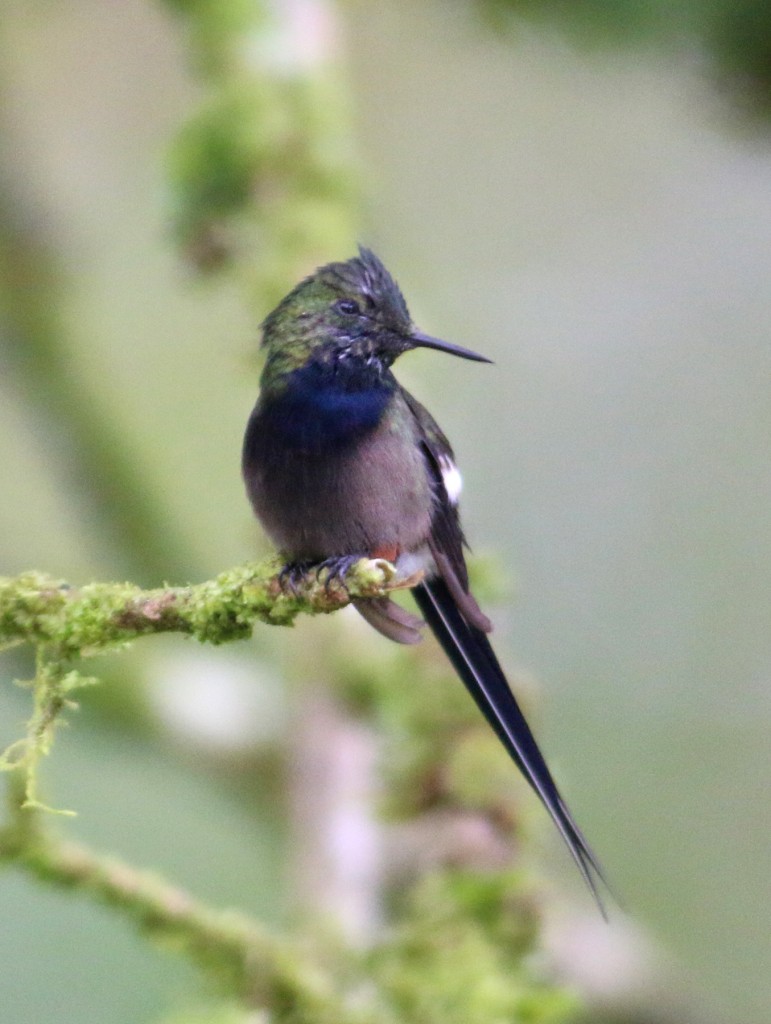
Wire-crested Thorntail, one of the more distinctive hummingbirds that we saw at both Narupa Reserve and at Wildsumaco.
We were often too tired to do much owling, but one night we managed a post-dinner burst of energy to walk along the access road, hearing Tropical Screech-owls and spotting an unidentified nightjar with its bright eyeshine hunting in a field by the entrance to the F.A.C.E. Trail.
This might be a good time to mention the weather pattern. During our days at both Narupa Reserve and at Wildsumaco, we had considerable rain throughout the days, yet somehow the rain didn’t interfere with our birding. Most days typically started clear and dry, allowing a morning of good birding, but then around lunchtime we had some strong downpours. I call that great timing. The afternoons were more spotty weather-wise, but after the mid-day showers birding picked up, and by evening we were completely exhausted. So in a way we were thankful for the showers, since they forced us to rest for a while indoors or on the veranda, the rains often resulted in better birding afterwards, and we always had a full day of birdwatching. On our final morning the sun finally emerged for a full day and we enjoyed a clear view of the conical peak of Sumaco Volcano.
Despite the fact that Wildsumaco has a deservedly strong reputation, the lodge was relatively empty during our stay. On our first night we overlapped with a group of ~12 birders, on the second night we shared the facilities with a single birder and his guide, and on the third night we were the only patrons. It is quite nice to feel like an entire lodge and its property is entirely yours.
There are so many species that can be seen here, and despite having four full days, we felt like we barely scratched the surface. As an example, our drive back out along the access road toward our next destination yielded Speckled Chachalacas with three young, a Channel-billed Toucan, Long-tailed Tyrant, a pair of preening Chestnut-fronted Macaws, and Lineated Woodpecker. Imagine how many more great species are lurking here.

